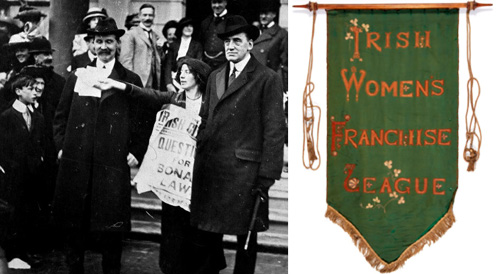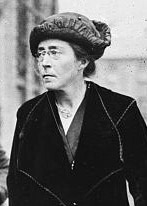“Where Tipperary Leads, Ireland Follows“.
Quote by Thomas Davis, editor of ‘The Nation Newspaper’ in the 1840’s.
A headstone, marking the grave of the Irish suffragette better known as Meg Connery, was unveiled in Dublin yesterday.

Margaret (Meg) Knight (1881–1958), was an Irish suffragette and feminist activist, born near Westport, in Co. Mayo, in 1881, the third of nine children. In 1922 she would be part of the delegation sent to review the destruction in Thurles and elsewhere in the wider county of Tipperary.
Mrs Connery was a strong advocate of women’s voting rights, conveyed publicly through her public speaking, lobbying, protesting and the publishing of articles in a variety of publications, especially in the Irish Citizen newspaper.
The Irish Citizen newspaper, itself, was founded in 1912, by the Irish Women’s Franchise League, latter founded in 1908.
Amongst its founder members were Mrs Hanna Sheehy-Skeffington, (former resident of Loughmore, Templemore, Co. Tipperary, latter village just 11.4km from Thurles), [VIEW HERE]; her husband Francis Sheehy-Skeffington (1877-1946) [Note: latter executed in Portobello Barracks, today known as Cathal Brugha Barracks, in Rathmines, Dublin), together with Thomas MacDonagh executed revolutionary leader and signatory of the Proclamation of the Irish Republic, (born in Cloughjordan, Co. Tipperary, latter village just 39.7km from Thurles), and strict vegetarians Margaret Cousins and her husband; teacher, author, actor, poet and play write James Henry Cousins (1873–1956). [Latter is credited with the quote, “Wisdom is wisdom only to the wise,” and once suspected of getting ‘too close’ romantically, to Maud Gonne, (to the annoyance of poet W. B. Yeats), following the execution of her husband, the Irish republican and military leader John MacBride).
A leading figure in the Irish Women’s Franchise League, Mrs Meg Connery, where possible, heckled and disrupted political meetings, and was a strong believer in the use of physical force in her pursue for voting rights for women. After spending most of her life in Dublin, Meg’s activities, much like that of her close friend Hanna Sheehy-Skeffington’s, included breaking windows in the Customs House, Dublin Castle, London War Office, going on hunger strike being imprisoned and beaten in her pursuit of equality for women.
During World War I which saw the introduction of the Contagious Diseases Act, Meg protested feeling the purpose of the Act was to make sex safe for male soldiers and sailors. In 1915 the British government closed the North Sea for a number of days around the International Women’s Peace Conference in The Hague thus leaving Irish women unable to attend.
Meg’s final years on this earth were difficult due to failing health and poverty. and up until yesterday an unmarked grave in Mount Jerome Cemetery in Harold’s Cross, Dublin, marked the burial place of Meg Connery and her husband Con Connery, whom she had married 49 years earlier in Clonmel, Co. Tipperary, in 1909.
Thurles.Info now asks the question, “Why is this historic information not being used as bate to attract/promote badly needed tourism to both Thurles town and the wider county of Co. Tipperary?


Leave a Reply